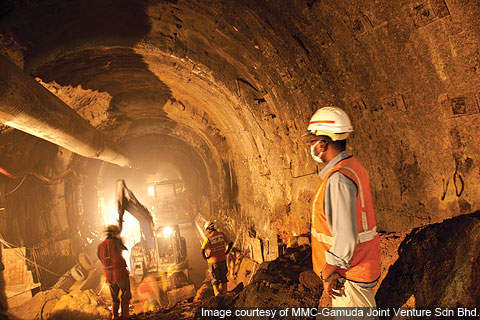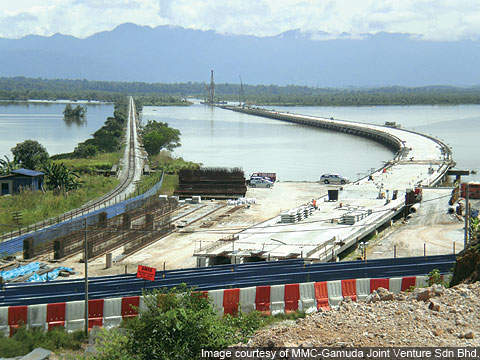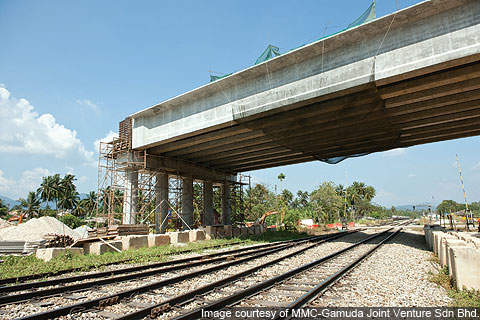The Malaysian Government has undertaken the Electrification of Double Track Project (EDTP), which runs through the four states of Perak, Penang, Kedah and Perlis in the northern peninsular region of Malaysia. The project involves the laying and electrification of a 329km-long double track near the existing single track that runs from Ipoh in Perak to Padang Besar in Perlis.
The project, which began in January 2008, was 42% complete in April 2010 and is expected to be completed by December 2013. It employs 150,000 people across various sectors.
The project is expected to handle 28 million passengers in 2013 compared with 20.7 million passengers in 2008, an increase of 35%. There will also be a 56% increase in cargo services, from 37.09 million tons in 2008 to 58 million tons in 2013.
The project is part of a master plan to improve the public transport system in Malaysia. Road transport constitutes 89% (as of April 2008) of the transportation system in Malaysia, causing congestion on the expressway. Rail transport, in contrast, constitutes only 3% due to the low speed of electric trains, which makes journeys time consuming.
The project also aims to improve the profits of loss-making national operator, Keretapi Tanah Melayu Bhd (KTMB), by increasing the turnaround of its existing rolling stock and effective usage of its wagons.
In 2006, KTMB earned RM113m from freight services, which is expected to increase by 628% on completion of the project (70% of KTMB’s revenue comes from freight services). The number of inter-city coaches will also increase by 5.6% each year.
On completion, the train frequency will increase to ten minutes from the current 15 minutes during peak hours. The frequency during peak times will be 15 minutes, reduced from the current 20 minutes. There will also be ten times more train services than the current 22 services offered daily, resulting in the rise of the average daily passenger volume to from 101,000 to 130,000.
Malaysian railway line routes
The project runs between Ipoh in Perak to Padang Besar in Perlis, located in north Malaysia and the border town with Thailand.
The project covers four states, Perak, Penang, Kedah and Perlis. The first section stretches from Ipoh to Butterworth for 171km. The second section stretches from Bukit Meritahan to Padang Besar for 158km.
The construction of the first section will be given high priority as it is a continuation of the Rawang-Ipoh line, which will eventually shorten the distance between Kuala Lumpur and Butterworth to three hours from the current nine hours.
Malaysia’s costliest rail project
Estimated to cost RM16.5bn, the Ipoh-Padang Besar electrification is Malaysia’s largest and costliest railway project.
A multi-layer construction method is being followed, in which the construction takes place in a sequence from the bottom of the ground to the stations on the surface of the ground, to the signalling systems. This method facilitates simultaneous construction in all four states.
Two million pieces of pre-cast concrete sleepers, 1.5 million tons of cement and 400,000t of steel will be required to build the entire railway line.
EDTP project
The EDTP project was initially conceived in 2003 but was shelved by the new government due to increasing deficits of the state. The project was again resumed in 2007 and was awarded to the MMC-Gamuda joint venture, who was also the contender of the project in 2003.
The project was given a temporary stop order by the Penang State Government in December 2008 as MMC-Gamuda had not furnished the track-laying plan for a 63km stretch. The order was issued with regards to a flood caused due to damage in the river bund in Titi Hitam, Seberang Prai, during the construction of the Ipoh-Padang Besar electrified double track. The project resumed again in January 2009 on the grounds that it is a national importance project.
The EDTP project was awarded to MMC-Gamuda, an equal joint venture partnership, on a design and build basis for a lump sum amount of RM12.48bn in July 2008. The contract was awarded with a precondition that any extra cost related to the project was to be borne by the main contractor. The project cost has now increased to RM16.5bn due to a rise in oil and steel prices.
In September 2008, it was reported that Betterworth to Pedang Besar would not be electrified as this section would mostly be used for the movement of cargo. This move is expected to reduce the project cost by a few hundred million Malaysian ringgit.
In December 2009, it was announced that the project completion date would be extended from December 2013 to January 2013, due to late approvals of the design and delays in the handover of the land caused by the relocation process of 3,000 squatters.
Ipoh-Padang Baser EDTP infrastructure
The project involves the laying of two new 329km-long parallel tracks to replace the existing single track, including new stations, bridges, the electrification of tracks and signalling systems.
The bridges required include 66 road over bridges, eight under bridges, 75 river bridges and 45 motorcycle / pedestrian bridges. A 282m swing bridge in Prai and a 3.5km marine viaduct at Bukit Merah will be constructed to accommodate the electrified double tracking system.
A total of 21 stations (four major and 14 minor) will be built. The four major stations, Perak, Penang, Kedah and Perlis, will have minor stations between them. The project also requires the construction of ten halts, three depots, and 180km of culverts and drainage works.
Two double-barrel tunnels have been built as part of the project. These include a 3.3km-long tunnel in Bukit Berapit, which is the longest in south-east Asia, and a 330m-long tunnel in Larut near Taiping. The construction of both tunnels was completed in May 2010.
To provide accommodation for KTMB staff, 220 quarters will be built.
EDTP rolling stock
The double track is designed to cater for electric trains with top speeds of 160-180km/hr, though the operator is expected to maintain speed levels between 140-160km/h.
KTMB uses three-car electric motivated units (EMU) operated by KTM Komuter Commuter Service, which will now be expanded to six-car EMUs manufactured by Mitsubishi Electric and Rotem.
KTM received its first six-car EMU on 10 December 2009, to service the Seremban-Kuala Lumpur-Ipoh sector that became operational in April 2010. The sector will be extended to Padang Besar in 2013, after completion of the project.




